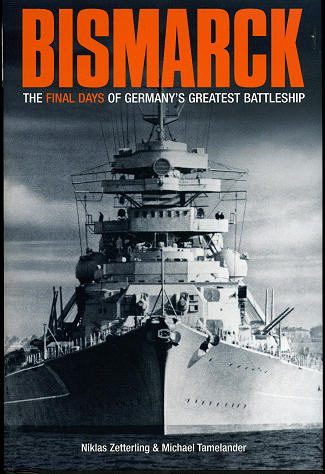 One of the
best known events in WWII naval history is the hunt for and the destruction of
the German battleship Bismark. Thanks
to a movie, a popular song, and decades later, the discovery of the ship itself
on the bottom of the Atlantic, the Bismark has been kept alive for
many. There have also been a substantial number of books on the subject to which
you can add this one, a book that tells the story based on interviews with
survivors and brings together all that is new from the last several decades.
One of the
best known events in WWII naval history is the hunt for and the destruction of
the German battleship Bismark. Thanks
to a movie, a popular song, and decades later, the discovery of the ship itself
on the bottom of the Atlantic, the Bismark has been kept alive for
many. There have also been a substantial number of books on the subject to which
you can add this one, a book that tells the story based on interviews with
survivors and brings together all that is new from the last several decades.
It starts with a look back at naval developments in
ships and their operations from the mid-late 1800s until the Bismark
was built and put to sea. One often does not realize the purpose of these sorts
of ships and we are given an excellent background into German naval planning in
general, and the construction of the types of ships that Germany built in
particular. Specifically these large ships were never built to slug it out with
enemy (and in this case that means British) battleships. German naval surface
power would never be able to successfully rid the oceans of the British Navy, so
their efforts were put into what is known as cruiser warfare. This is the use of
ships that were able to seek out convoys and sink as many merchant ships as
possible, all the time avoiding battle with big-gun British ships.
The background section covers all of the German surface
actions in this regard up until the sailing of the Bismark, and to this
reviewer, is an important part of the story itself. It shows how the ship was to
be used and the motives behind its deployment.
Secrecy and breaking out into the Atlantic undetected
were keystones to the operation of the Bismark and other German surface
ships. The plan was to find convoys and sink as many ships as possible. This was
a task that was not as easy as it seems, and often convoys escaped undetected.
When they were discovered, the results were the sinking of a large number of
ships, but not as many as hoped. With the advent of radar, the ability to pass
bottleneck areas undetected was greatly reduced. The truth is that cruiser
warfare was never an effective means of sinking enemy ships. Far more were
destroyed by mines or aircraft than surface raiders and of course, the huge toll
taken by submarines was the major reason that Germany stopped concentrating on
large surface ships after the loss of the Bismark.
The story of the Bismark itself is superbly
told and the authors provide what has to be the best rendition of the ship's
final and only combat voyage. Their interviews add a great deal of life to the
story of the men who served on the ship and how they reacted to combat and the
final destruction of Bismark. It is a story that is brought to life in
these pages and is a book that is by far the best on the subject that I have yet
read. For this reason, it is a title I can highly recommend to you as I know you
will be as drawn into events as was I.
July 2009
Review book courtesy of
Casemate Publishing, where you can order your copy of this and many other superb books.
If you would like your product reviewed fairly and quickly, please contact
me or see other details in the Note to
Contributors.
 One of the
best known events in WWII naval history is the hunt for and the destruction of
the German battleship Bismark. Thanks
to a movie, a popular song, and decades later, the discovery of the ship itself
on the bottom of the Atlantic, the Bismark has been kept alive for
many. There have also been a substantial number of books on the subject to which
you can add this one, a book that tells the story based on interviews with
survivors and brings together all that is new from the last several decades.
One of the
best known events in WWII naval history is the hunt for and the destruction of
the German battleship Bismark. Thanks
to a movie, a popular song, and decades later, the discovery of the ship itself
on the bottom of the Atlantic, the Bismark has been kept alive for
many. There have also been a substantial number of books on the subject to which
you can add this one, a book that tells the story based on interviews with
survivors and brings together all that is new from the last several decades.